The avalanche probe was already a good meter in the snow when it encountered the resistance it was hoping for. Its tip finally hit Sepp Hümmer’s body there under the snow cover. For the third time within a few minutes, the experienced mountain guide has been tracked down in the snow cave that the rescuers from the mountain rescue service and the alpine police task force had previously dug for him. Police dog Bep sniffed it out for the first time, dog handler Harald Elsner from the Rosenheim Presidium quickly dug it up and then immediately shoveled it in again so that mountain rescue dog Thea could also show off her skills. And now it is the Prime Minister himself who is locating Sepp Hümmer with the avalanche probe.
Markus Söder came to the Zugspitze on Tuesday together with Interior Minister Joachim Herrmann and a large entourage to be informed and the general public by the Bavarian Board of Trustees for Alpine Safety about the safety situation in winter sports. And of course the Prime Minister is happy to take the beautiful photos and television pictures from the snow on Germany’s highest mountain with him into the valley and into the beginning of the election year.
Originally, the Board of Trustees, a merger of practically all Alpine organizations of any kind, from the Alpine Club to the Mountain Rescue Service and the Ski Instructors’ Association, wanted to schedule its demonstration one floor down on the nearby Kreuzeck above Garmisch-Partenkirchen. But the difference in altitude of around a thousand meters between the ski area up on the Zugspitzplatt and the Kreuzeck also makes the difference between white and green. And a credible backdrop for the rescue of avalanche victims should be really white.
A ski slope that consists of a narrow and often hard strip of white artificial snow in the middle of green meadows and gray rocks is much more dangerous than a descent that is also surrounded by deep and, at best, soft snow. Just a few days ago, near Kitzbühel, two young people from Bavaria died after coming off the slope and falling into snow-free rocky terrain. In the mountains over in Austria, 13 people have died in accidents since the beginning of this winter, most of them on ski slopes, says the chairman of the Bavarian mountain rescue service, Thomas Lobensteiner. There are currently 18 fatalities in the entire Alpine region. So far this winter there have been no deaths in the Bavarian Alps – none yet, as experience has shown to be feared. Because in the 2021/22 winter season, according to Lobensteiner’s mountain rescue service statistics, 19 people died in Bavaria’s mountains, four of them in avalanches.
The Belgian shepherd Bep and his dog handler Harald Elsner from the Rosenheim police in a simulated search operation.
(Photo: Angelika Warmuth/dpa)
The number of deaths has increased steadily in recent winters, while the number of mountain rescue missions has decreased in the meantime. In the 21/22 season, according to Lobensteiner, the mountain rescue service was just as challenged with almost 5,500 missions as before the corona pandemic, which, according to Interior Minister Herrmann, also applies to the Bavarian police with 121 “winter sports-related” missions. Skiers were affected in almost 60 percent of all winter mountain rescue operations, snowboarders in a good twelve percent and tobogganists in around four percent. Away from the groomed pistes, these sledgers make up the largest group of casualties, with a significant gap to cross-country skiers, touring skiers and snowshoe hikers. A number of mountaineers also had to be rescued last winter. According to Lobensteiner’s experience, which is supported by statistics, winter accidents in summer sports such as mountain biking have recently increased. A bike park has opened in the Bavarian Forest these days, while normal skiing is hardly possible due to a lack of snow.
Climate change is more noticeable in the Alps than in the lowlands, says Prime Minister Söder, which can be seen from the dwindling permafrost on the Zugspitze. You have to “sometimes also protect the mountain from people”, it requires “a sensitive approach to our homeland” as well as a certain adaptation to climate change. “Snowmaking systems will also be needed,” says Söder, because “we believe in the future of winter sports”.
Stefan Winter, head of the department for sports development at the German Alpine Club and member of the Board of Trustees for Alpine Safety, recalls the personal responsibility of winter sports enthusiasts. Skiing off the groomed slopes, for example, is “not careless per se” in his eyes, but requires experience and the necessary knowledge. The Board of Trustees wants to convey this knowledge in various ways, recently also with a memory game on different weather conditions, snow crystals and types of avalanches. The knowledge acquired in a playful way should enable winter sports enthusiasts to make a better risk forecast. The chairman of the board of trustees and Rosenheim CSU member of the state parliament Klaus Stöttner hopes that it will soon be played as often in mountain huts as on training evenings. According to Minister Herrmann, in addition to forecasting external risks, correct self-assessment and good preparation when choosing a tour are also important.

